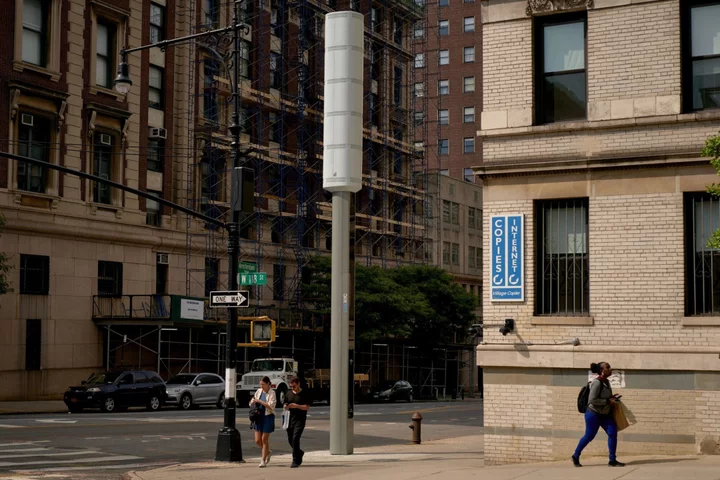In New York, an Upper East Side enclave is fighting city plans for curbside 5G towers, calling them “garish” and unnecessary, in a campaign that presages battles around the US sparked by an explosion in wireless gear on public streets.
Carnegie Hill, which stretches from Fifth Avenue’s Museum Mile along Central Park into tranquil tree-lined blocks, is home to luminaries such as JPMorgan Chase & Co. Chief Executive Officer Jamie Dimon and private equity titan Ken Chenault. Swept sidewalks adorned with flower boxes front graceful condo buildings and Andrew Carnegie’s mansion, which ratified the quarter as upscale when it was built 120 years ago.
The neighborhood is working to fend off its share of some 2,000 cell towers to be deployed around the city. At 32 feet high (9.8 meters), the structures are tall enough to loom outside a bedroom window.
“They are awful, ugly, Brutalist” and out of context in a historic neighborhood, said Joanna Cawley, executive director of the local civic group Carnegie Hill Neighbors. The neighborhood, one of more than a dozen around the city fighting the plan, has engaged a public relations firm and started a “Stop 5G Towers Fund.”
The structures are part of efforts to expand access to reliable, high-speed Wi-Fi and cellphone service, especially in underserved areas. The city accuses critics of NIMBYism, referring to a “not-in-my-backyard” mentality. The project is run by a group called CityBridge LLC, with roots including Google funding, that’s under city contract and operates using the LinkNYC label.
Similar tensions are set to be repeated across the country, as wireless providers move to blanket cities and towns with access to fast 5G — and with the gear to broadcast its signals, which rapidly lose strength and peter out within a few hundred feet. The new network needs an abundance of transmitting cell sites, which are typically the size of a backpack and affixed to tall poles or traffic lights.
“We’re going to continue to see conflict” between a city or an internet service provider “and residents who don’t want to see a pole in their front yard,” said Angelina Panettieri, legislative director, information technology and communications, for the National League of Cities.
Carnegie Hill Neighbors, whose district is slated for six of the new 5G towers, wants a citywide moratorium on installations while an alternative is sought, Cawley said. At the group’s urging, New York Democratic Representative Jerrold Nadler asked US officials to assess the towers’ effect on historic districts. The Federal Communications Commission in April called for reviews, slowing deployment.
A Carnegie Hill bulletin lists Dimon and Chenault as donors to the neighborhood group but doesn’t disclose who gave to the 5G towers fund specifically (the group offers large tote bags to donors of $5,000 or more.) Representatives for Chenault and Dimon declined to comment. Chenault has signed a letter of support for the tower deployment across the city.
US wireless providers began offering 5G to the public in 2019, and the rollout is accelerating. The technology offers ultrafast speeds and high capacity, letting the network connect legions of devices, including baby monitors, vehicles, smart watches, industrial monitors, drones and virtual-reality headsets.
The so-called small cell sites that house the 5G transmitters are set to grow by more than 1 million in the US over the next decade, from about 211,000 in 2022, according to S&P Global Market Intelligence. All that gear has to go somewhere, fueling tension between localities worried their streets may be marred by industrial dreck, and the companies serving up wireless connections.
“We are going to have to figure out a way to cooperatively work with communities to get this network infrastructure deployed,” Federal Communications Commission Chairwoman Jessica Rosenworcel told lawmakers in June. “And I don’t want those relationships to be hostile, friction-filled, or aggressive.”
The towers have attracted support among those focused on improving service in “internet deserts,” such as the Bronx.
“We need partners like LinkNYC who are committed to dismantling systemic barriers to accessing Wi-Fi connectivity,” Bronx Borough President Vanessa Gibson said in an email. “As more affluent neighborhoods might have stable connectivity and are opposing the kiosks in their communities, it is not the same reality for many of our residents and families in the Bronx.”
About 90% of the towers are slated to be installed in the Bronx, Brooklyn, Queens and above 96th Street in Manhattan, spreading the service beyond the richest parts of the city. So far New York has rolled out 107 and 86 have been activated to supply Wi-Fi to nearby users. Six community boards in Manhattan and 10 more in other boroughs have expressed opposition to the towers.
Members in the CityBridge group include out-of-home advertising company Intersection, and an infrastructure specialist formerly called ZenFi Networks, now part of Boldyn Networks. It plans to make money from fees charged to 5G wireless providers, and from advertising on video screens attached to some of the smart poles.
“Contrary to the handful of vocal NIMBY groups who support the unequal status quo, we believe our residents and visitors deserve the same connection quality wherever they work, live, or travel throughout the five boroughs,” said Ray Legendre, a spokesperson for the city’s Office of Technology and Innovation.

